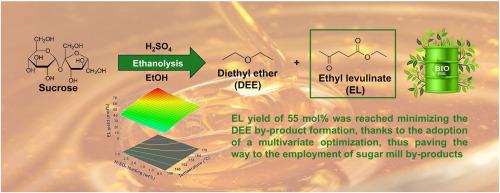Multivariate approach for the optimization of sucrose ethanolysis: Paving the way to the exploitation of sucrose-rich by-products
IF 5.8
2区 生物学
Q1 AGRICULTURAL ENGINEERING
引用次数: 0
Abstract
The depletion of fossil resources is making the synthesis of renewable compounds urgent. Ethyl levulinate (EL) represents a strategic compound within the biorefinery process, being a valuable intermediate, solvent and biofuel additive of renewable origin. The one-pot ethanolysis is the preferred route for its synthesis, but the proper optimization of the reaction conditions to maximize the EL yield and minimize the critical by-products formation, diethyl ether (DEE) and humins, is still a challenge. In this regard, the present work aims at the optimization of sucrose ethanolysis through the multivariate approach, adopting H2SO4 as catalyst and following the high gravity approach (10.5 wt% sucrose loading), which allows the obtaining of concentrated EL streams, increasing productivity and making downstream operations easier and cheaper. The optimization allowed a compromise between the highest EL yield and the lowest DEE production, thus simplifying EL purification and consuming less solvent that can be recycled in the following run. Under these conditions, the humins formation was also kept low and, for the first time, not only the solid humins were characterized, proving to be suitable as solid fuel turning into a co-product of the process, but also the chemical structure of the soluble ones was investigated. For the first time, a preliminary study regarding the ethanolysis of thick juice was also performed, thus opening the way to the employment of low-cost sucrose-rich feedstocks as substrate for the synthesis of EL. Thus, this work contributes to making the synthesis of a strategic renewable compound as EL more sustainable.

蔗糖醇解优化的多变量方法:为富蔗糖副产物的开发开辟道路
化石资源的枯竭使得可再生化合物的合成迫在眉睫。乙酰丙酸乙酯(EL)在生物炼制过程中是一种重要的化合物,是一种有价值的可再生中间体、溶剂和生物燃料添加剂。一锅醇解法是其合成的首选途径,但如何优化反应条件以最大限度地提高EL产率,并最大限度地减少关键副产物二乙醚(DEE)和人敏素的生成,仍然是一个挑战。在这方面,本研究旨在通过多元方法优化蔗糖醇解,采用H2SO4作为催化剂,采用高重力方法(10.5%蔗糖负荷),从而获得浓缩的EL流,提高生产率,使下游操作更容易,成本更低。该优化在EL的最高产率和DEE的最低产率之间进行了折衷,从而简化了EL的纯化,并减少了可在后续运行中回收的溶剂的消耗。在此条件下,人肉素的生成也保持在较低水平,并且首次对固体人肉素进行了表征,证明固体人肉素适合作为固体燃料转化为该过程的副产物,同时对可溶性人肉素的化学结构进行了研究。本文还首次对浓汁的醇解进行了初步研究,为利用低成本的富蔗糖原料作为底物合成EL开辟了道路。因此,这项工作有助于使战略可再生化合物EL的合成更具可持续性。
本文章由计算机程序翻译,如有差异,请以英文原文为准。
求助全文
约1分钟内获得全文
求助全文
来源期刊

Biomass & Bioenergy
工程技术-能源与燃料
CiteScore
11.50
自引率
3.30%
发文量
258
审稿时长
60 days
期刊介绍:
Biomass & Bioenergy is an international journal publishing original research papers and short communications, review articles and case studies on biological resources, chemical and biological processes, and biomass products for new renewable sources of energy and materials.
The scope of the journal extends to the environmental, management and economic aspects of biomass and bioenergy.
Key areas covered by the journal:
• Biomass: sources, energy crop production processes, genetic improvements, composition. Please note that research on these biomass subjects must be linked directly to bioenergy generation.
• Biological Residues: residues/rests from agricultural production, forestry and plantations (palm, sugar etc), processing industries, and municipal sources (MSW). Papers on the use of biomass residues through innovative processes/technological novelty and/or consideration of feedstock/system sustainability (or unsustainability) are welcomed. However waste treatment processes and pollution control or mitigation which are only tangentially related to bioenergy are not in the scope of the journal, as they are more suited to publications in the environmental arena. Papers that describe conventional waste streams (ie well described in existing literature) that do not empirically address ''new'' added value from the process are not suitable for submission to the journal.
• Bioenergy Processes: fermentations, thermochemical conversions, liquid and gaseous fuels, and petrochemical substitutes
• Bioenergy Utilization: direct combustion, gasification, electricity production, chemical processes, and by-product remediation
• Biomass and the Environment: carbon cycle, the net energy efficiency of bioenergy systems, assessment of sustainability, and biodiversity issues.
 求助内容:
求助内容: 应助结果提醒方式:
应助结果提醒方式:


